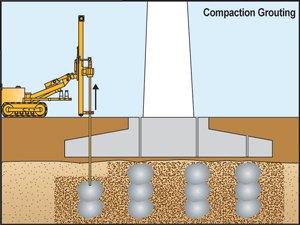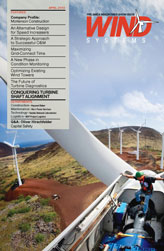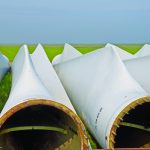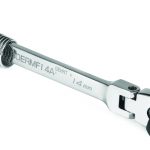When the site of a planned wind tower is underlain by sufficiently dense granular soils, a mat foundation can be designed to safely support the structure. If the soils are too loose they may provide insufficient bearing capacity, result in excessive static deformation, or undergo unacceptable performance during a seismic event (liquefaction or excessive dynamic settlement). If the loose conditions are discovered prior to construction, options include bypassing the loose soils with a deep foundation or improving the existing soil conditions. Pre-construction soil improvement techniques include vibro compaction, dynamic compaction, and compaction grouting. Of these techniques, compaction grouting is the only one that can be used both pre-construction and beneath an in-place foundation.
Compaction grouting involves injection of a mortar grout to displace and densify surrounding soil. The grout is very viscous (“low-mobility”) and primarily consists of Portland cement, sand, and water. An injection pipe is either drilled or driven to the bottom of the soils requiring densification. The grout is then pumped through the pipe as it is extracted in 1-3 foot stages. As the grout is pumped into each stage it displaces and densifies the surrounding soils. The injection holes are often sequenced in primary to secondary to tertiary locations, such that soil can be confined and effectively densified. This process can be performed to achieve significant improvement, which is fully verifiable with post-treatment field testing.

In order to prepare an effective grouting program, a geotechnical engineering consultant must develop a report containing site geological history, soil engineering properties (including density, gradation, and moisture content), and the in-situ permeability of each treatment stratum. Location and information about adjacent structures and utilities are also required.
For optimum compaction grouting results the vertical stress (overburden) on the treatment stratum must provide adequate confinement, such that the grout displaces the soil horizontally rather than vertically, so as not to cause surface movement (heave). Overburden stresses greater than 1,500 psf are typically required to maximize densification. However, densification can be achieved with less overburden pressure, but production and technical limitations may exist.
When compaction grout is injected into saturated soils, pore pressure will increase due to the added volume. This increased pressure must dissipate for effective densification to take place. Therefore, the grout injection rate should be slow enough to allow pore pressure dissipation. As weaker soil strata will undergo more densification, increased grout volume is often required in these layers. Hydro-collapsible soils can usually be treated effectively by adding water during drilling prior to compaction grout injection; in this case the soil is collapsed during drilling and densified by the subsequent grouting. Thinly stratified soils can cause difficult or reduced improvement capability as grout takes preferential paths during injection. Soils that lose strength during remolding—such as saturated, fine-grained soils and sensitive clays—should be avoided. Typical treatment spacing ranges between 6-10 feet. Based on hole spacing, the anticipated grouting volume per stage can be calculated. Often, a maximum injection pressure criterion is established to prevent fracture and ground heave. Vertical stages are usually set at 2-3 foot intervals, with tighter grid spacing generally leading to better results.
Quality control measures include: 1) procedural inspection and documentation of the work activity; 2) testing to ensure proper mix design; 3) monitoring of grout injection rates, volume, and pressure, and; 4) post-treatment verification of ground improvement. When applied properly, compaction grouting can provide the necessary improvement of granular soils for many wind turbine sites, allowing for a shallow foundation system. In most cases, mat foundations constructed on improved soil will provide an economic advantage over deep foundation options.
































